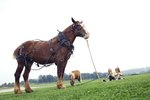
Before mechanization brought tractors to the fields, horses were the main source of power used to plow furrows in preparation for planting. In a nod to their strength, tractors today are categorized according to their "horse power" -- or how many horses it would take to accomplish the same power output. Plowing matches across the United States, Europe, Australia and New Zealand celebrate the history of plow horses.
Ancient Plowing
For centuries, oxen pulled plows. Their stout physique made them a powerful and effective choice. This began to change in 4th-century China, where inventors designed a horse collar that distributed a load's weight on the horse's chest and collar bones, according to Machine-History.com; previous collars centered the weight on the neck, leaving horses gasping for air. As horse breeders began selecting for strength in Medieval Europe, horses began to replace oxen for plowing.
Little Iron Horse
Nicknamed "little iron horse" for its versatility as a riding, carriage-pulling and plowing horse, the Canadian horse was the "go to" equine in the late 1700s and early 1800s when only the wealthy could afford horses dedicated to specific tasks, according to History.org. This breed stands only 5 feet tall at his withers -- the area where a horse's neck joins his shoulders. He rarely weighs more than 1,000 pounds, but is highly muscled. He originates from France and came to North America in 1665 when King Louis XIV shipped mares and stallions to Quebec.
Percheron
In the 1870s, the American expansion west demanded large, strong horses. The Civil War had drained much of the country's horse stock. In the 1880s, nearly 5,000 stallions and 2,500 mares were imported from Le Perch -- a French province known for agricultural excellence and heavy-duty horses. Percheron horses with an average weight of 2,000 pounds are well-muscled in their lower thighs, a characteristic that gained them a loyal following -- by the 1930s, more than 70 percent of draft horses in the U.S. were Percherons, and most major land-grant universities maintained a stable of the breed, according to the Percheron Horse Association of America.
Belgian
The Belgian horse is from Belgium, where breeders had long resisted pressure to produce a lighter, calvary-type horse and remained loyal to the stocky, massive horse called Brabant. This horse has a compact body with double muscling over his croup -- the topline of his hip and rump -- making him a strong choice for pulling plows through virgin soil. By 1937, the Belgian's population in the U.S. surpassed the Percheron, according to the Eastern Draft Horse Association.
Clydesdale
Perhaps better known by Americans today for pulling the Budweiser beer wagon, the Clydesdale -- a dark-colored bay with white fetlocks on his lower leg and white blaze down the center of his face -- played a significant role as a plow horse. Brought to North America by Scottish immigrants, the Clydesdale was the third most numerous draft horse in America by the end of the 19th century. He was No. 1 in Scotland, where more than 140,000 Clydesdale horses were agricultural workers at the end of the 19th century, says the Clydesdale Horse Society.
Suffolk Punch
The Suffolk punch, originating in eastern England, was developed solely to pull a plow efficiently through the countryside's heavy clay soil, according to All Aboard Farm. The largest of Suffolk punch horses stand approximately 16 hands tall -- still larger than most pleasure horses, yet significantly shorter than Clydesdales and Belgians, which average 16 hands but can be as tall as 19 hands. What it lacks in height, this horse makes up with power, stamina and a docile personality.
Plowing Matches
The agricultural legacy of plow horses is preserved via annual plowing matches in many countries. Draft horse enthusiasts compete in categories including antique plow, walking plow and two- and three-horse sulky -- that's a plow with a cart behind it so the plowman can ride. Competitors are judged on straightness and quality of their plow rows, quantity of ground plowed and time.
References
- Eastern Draft Horse Association:
- Equisearch: Breed Profile: Belgian Draft Horse
- History: Little Iron Horses
- Percheron Horse Association of America: Percheron History
- The Clydesdale Horse Society: Breed History
- All Aboard Farm: A Brief History of the Suffolk Punch Draft Horse
- American Livestock Breeders Conservancy: Suffolk Horse
- Machine-History: The Horse Collar
Resources
- New York Times: Farm Equipment That Runs on Oats
- History: Colonial Williamsburg's Rare Breeds Program Complements Living History Interpretation
- BBC: Scotland Outdoors: Orkney Ploughing Match
- Northwest Washington Fair: International Plowing Match
- Farm and Dairy: Playing in the Dirt: Draft Horse Plow Match Preserves the Skills of an Earlier era
Photo Credits
-
Digital Vision./Digital Vision/Getty Images
Writer Bio
Amy M. Armstrong is a former community news journalist with more than 15 years of experience writing features and covering school districts. She has received more than 40 awards for excellence in journalism and photography. She holds a Bachelor of Arts in communications from Washington State University. Armstrong grew up on a dairy farm in western Washington and wrote agricultural news while in college.




